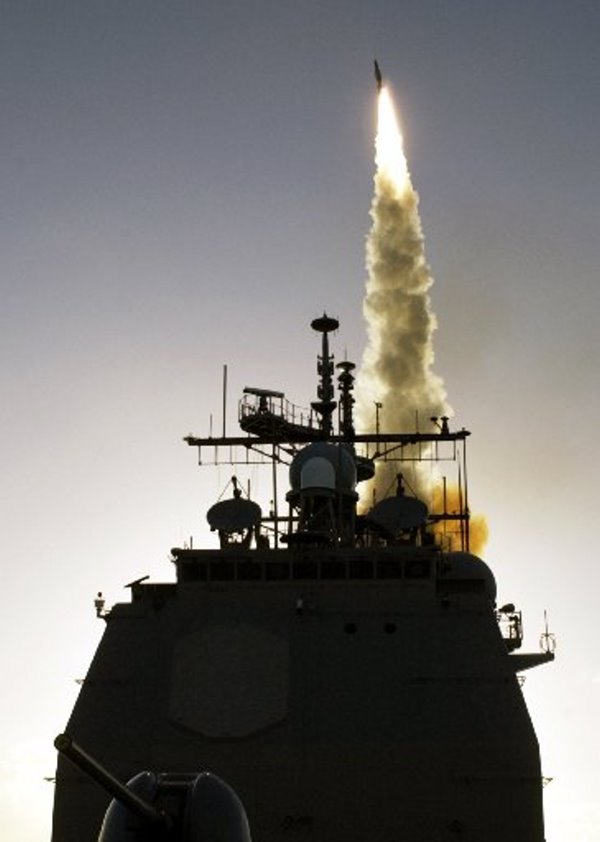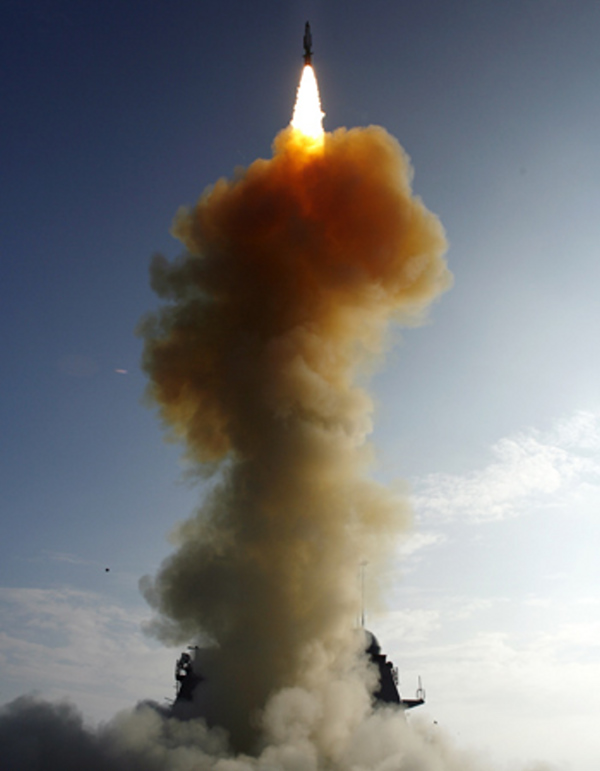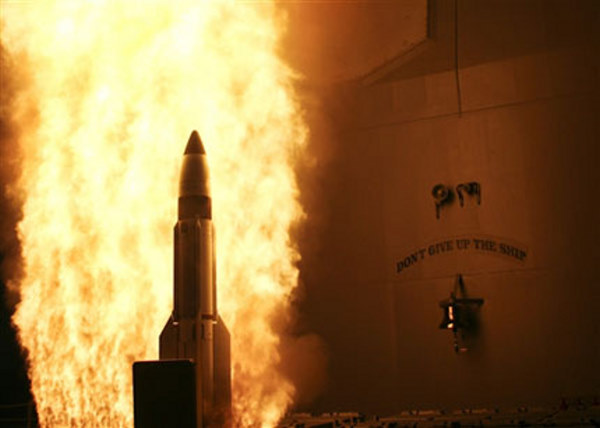|
.. |
|
|
Dec. 11, 2003 ..
In this Dec. 11, 2003 picture provided by the U.S. Navy, a Standard Missile-3 is launched from the Aegis cruiser USS Lake Erie in Kauai, Hawaii as part of the Missile Defense Agency's Ballistic Missile Defense System test against medium range ballistic missiles. The government issued notices to aviators and mariners to remain clear of a section of the Pacific beginning at 10:30 p.m. today, indicating the first window of opportunity to launch an SM-3 missile from the USS Lake Erie, in an effort to hit a crippled U.S. spy satellite. The Space Shuttle Atlantis returned to earth, landing shortly after 9 this morning, to avoid the possibility that the ship would be damaged when a missile, launched from the ground, destroys a disabled spy satellite that officials say malfunctioned shortly after it was launched in 2006 that may be carrying a hazardous load of fuel. Or classified information. Or both. And as if to ensure the spectacle of it all, the satellite may be destroyed mid-way through a total lunar eclipse, flanked by Saturn and Regulus, a bright start in the constellation Leo. Source: Rhode Island News February 20, 2008 Related Links:
|
|
|
..
ARLINGTON, VA — At 10:29 p.m. last evening the Navy confirmed it hit a falling and potentially dangerous defense intelligence satellite using an SM-3 missile fired from the deck of the USS Lake Erie in the Northern Pacific. Officials say the missile likely destroyed its intended target, a 1,000 pound tank of toxic hydrazine fuel. "There are good first indications the shot was successful. There was an explosion on impact and over 80 pieces of debris were detected after initial assessments," an official said. Source: Navy Missile Blasts Satellite, Fuel Tank Likely Destroyed |
|
| Navy missile hits dying spy
satellite, says Pentagon
February 21, 2008 The missile didn't carry a warhead, with authorities saying the impact was expected to be sufficient to destroy the fuel tank. Navy gunners had just a 10-second window to fire, and officials had said they might not be able to take their shot on the first opportunity. Earlier Wednesday, officials had expressed concern about weather conditions, saying the launch could be delayed. However, the 10-second window would have occurred on each of the next nine or 10 days. Video Watch Pentagon spokesman Jeff Morrell describe the launch window » Officials had said the missile would not be fired until the space shuttle Atlantis landed, which it did Wednesday morning, to ensure the shuttle would not be struck by any debris from the destroyed satellite. The attempt cost up to $60 million, according to estimates. Without intervention, officials say, the satellite would have fallen to Earth on its own in early March. However, since it malfunctioned immediately after it was launched in December 2006, it had a full tank -- about 1,000 pounds -- of frozen, toxic hydrazine propellant. Video Watch how the failing satellite failed to spark fears » The fuel tank probably would have survived re-entry if the satellite had fallen to Earth on its own. That could have dispersed harmful or even potentially deadly fumes over an area the size of two football fields. Hydrazine is similar to chlorine or ammonia in that it affects the lungs and breathing tissue. Source: Navy missile hits dying spy satellite, says Pentagon |
|
|
..
With a secondary explosion worthy
of the Star Wars franchise, a Navy missile designed for anti-missile defense
shot down a defunct spy satellite on Wednesday night. The cruiser USS Lake
Erie fired a vertically-launched SM-3 missile from its position northwest
of Hawaii at 10:26 pm (EST), and military planners continue to track the
debris.
“Thus far we’ve seen nothing larger than a football,” said Gen. James Cartwright, the vice chairman of the Joint Chiefs of Staff. The fireball indicates that the fuel tank was struck, he said at a news conference, since there are no explosive materials in the interceptor’s tip or on board the satellite. Now the real fallout begins: the debate over the so-called weaponization of space. After the China’s satellite shoot-down and yesterday’s success, it is clear that placing weapons in space is not needed to conduct war there. With orbiting platforms vital for military reconnaissance and communications, space is a battlefield that can and, one day, likely will be fought for. —Joe Pappalardo Source: Navy Missile Successful as Spy Satellite Is Shot Down |
|
|
.. Uploaded on Feb 21, 2008 The Navy not only succeeded in knocking a falling spy satellite out of the sky 130 miles up, but officials believe the missile interceptor struck the satellite's fuel tank, destroying the toxic goo before it could fall to Earth. "We have a hit!" was the radio message transmitted to the Pentagon three minutes after the missile was launched. |
|
| FAIR USE NOTICE: This page contains copyrighted material the use of which has not been specifically authorized by the copyright owner. Pegasus Research Consortium distributes this material without profit to those who have expressed a prior interest in receiving the included information for research and educational purposes. We believe this constitutes a fair use of any such copyrighted material as provided for in 17 U.S.C § 107. If you wish to use copyrighted material from this site for purposes of your own that go beyond fair use, you must obtain permission from the copyright owner. | |
|
|



